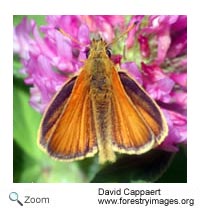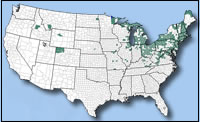European Skipper - Thymelicus lineola |
|||||||||
DescriptionThe European skipper has a wingspan of 1 inch. The uppersides of its wings are burnt orange with a dark brown border. The underside of its forewings is a dull orange and the underside of its hindwings is a grayish-brown. The male has a small, narrow black stigma on its forewings. The stigma is a section of scent cells located on the forewings of the males of some species of butterflies. Range HabitatThe European skipper is found in open grassy areas like meadows, hayfields, pastures, and roadsides. |
Diet
The European skipper caterpillar eats a variety of grasses, including Timothy grass,
cocksfoot, and
couch grass. The adult European skipper eats nectar from low growing flowers like
thistles, ox-eye daisy, fleabane, white clover, red clover, orange hawkweed, common milkweed, and swamp milkweed. Lifecycle
BehaviorThe European skipper is an introduced species in North America. In its native range in Europe and Asia, it is called the Essex Skipper. It was accidentally brought into London, Ontario in Canada in 1910 in a shipment of Timothy grass seeds. The range of the European skipper is expanding, perhaps because its eggs are sometimes transported with hay deliveries. |
||||||||


 In North America, there are two populations of European skippers. The eastern population is found from Newfoundland, Canada west to eastern North Dakota and south to Missouri, Kentucky, and the Carolinas. The western population is found in parts of Idaho, Montana, Colorado, Wyoming, and
Saskatchewan, Alberta, and British Columbia , Canada. The European skipper is also found in Europe and Asia. The European skipper is found in New Hampshire.
In North America, there are two populations of European skippers. The eastern population is found from Newfoundland, Canada west to eastern North Dakota and south to Missouri, Kentucky, and the Carolinas. The western population is found in parts of Idaho, Montana, Colorado, Wyoming, and
Saskatchewan, Alberta, and British Columbia , Canada. The European skipper is also found in Europe and Asia. The European skipper is found in New Hampshire. 